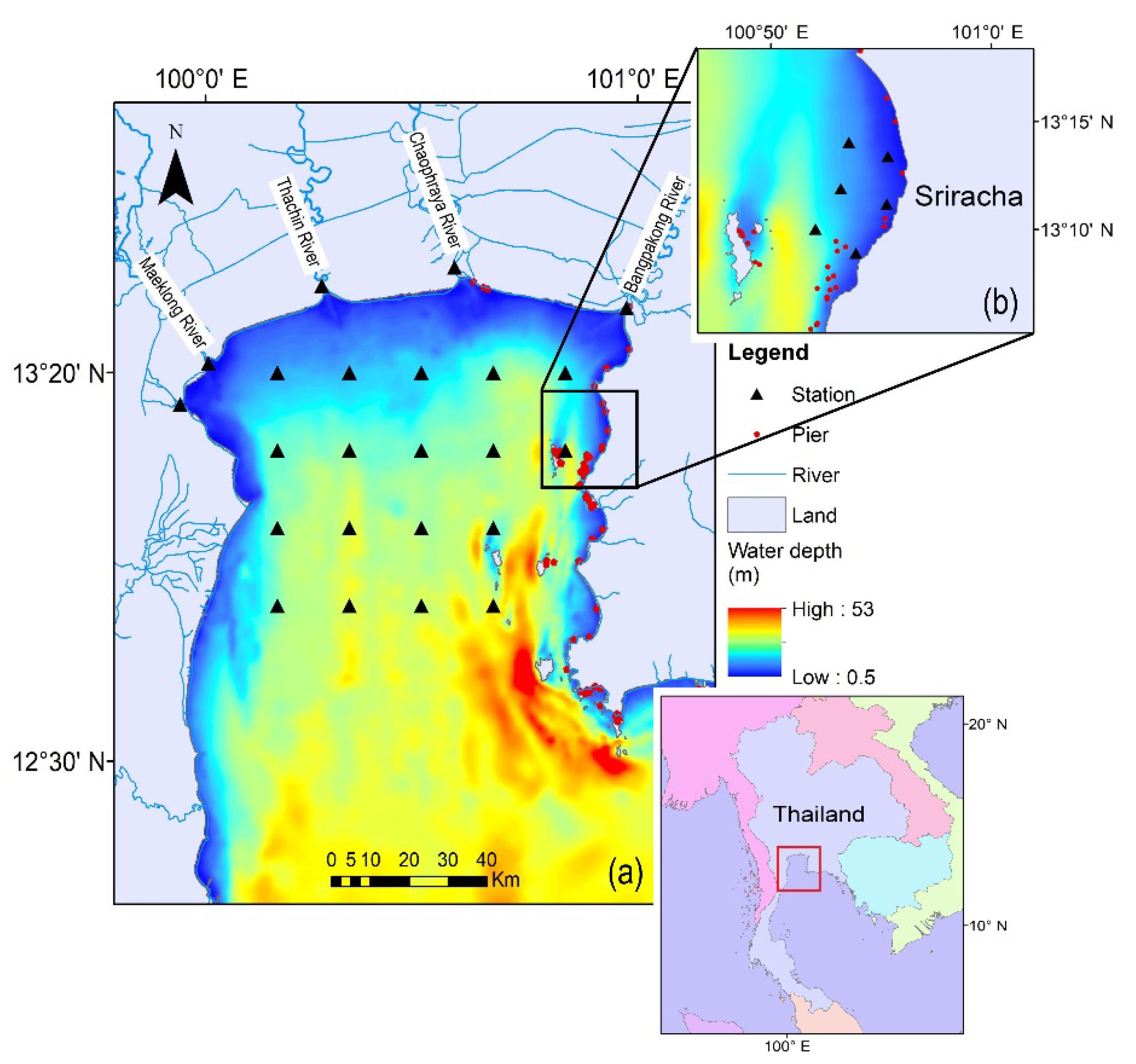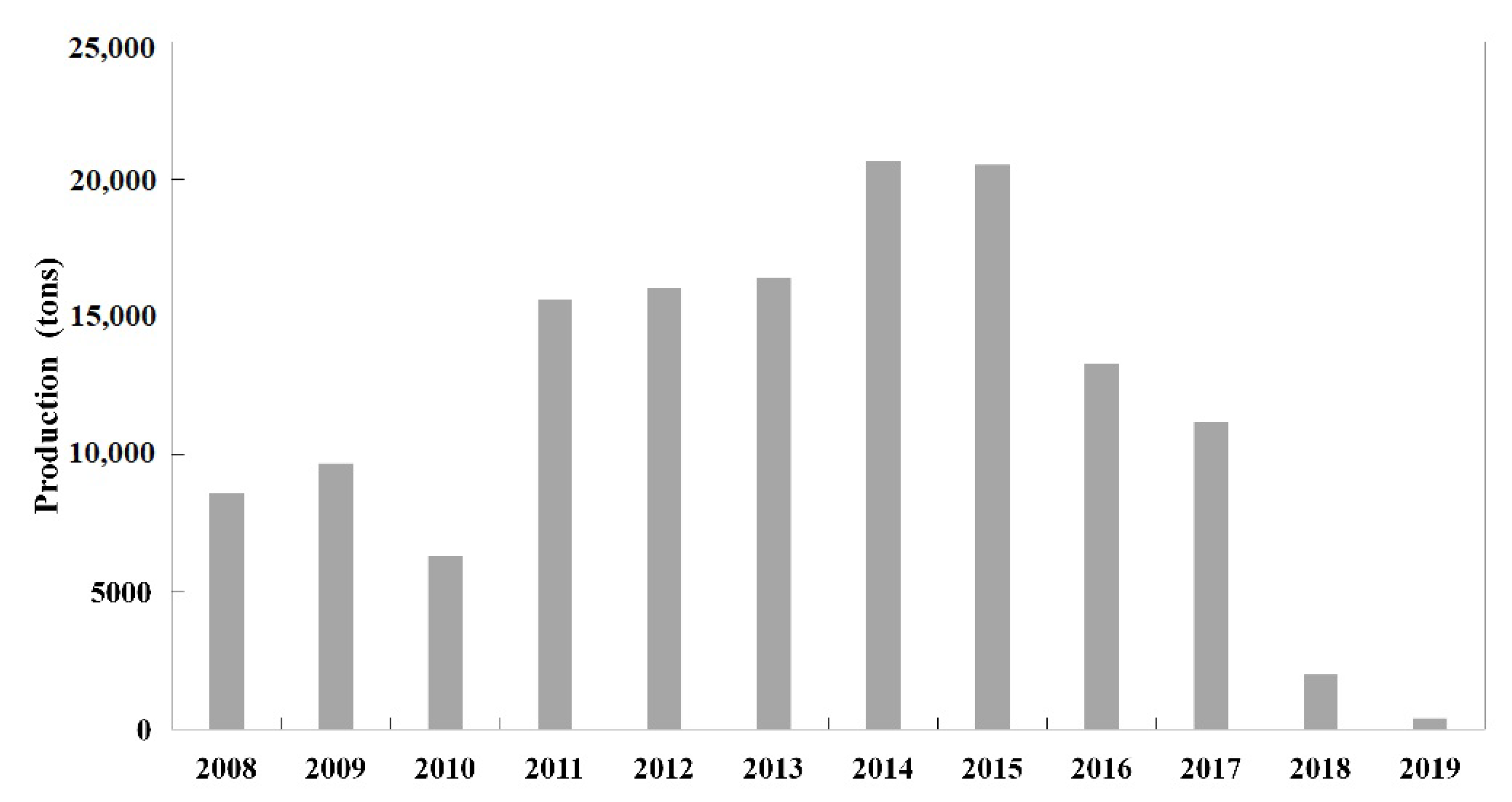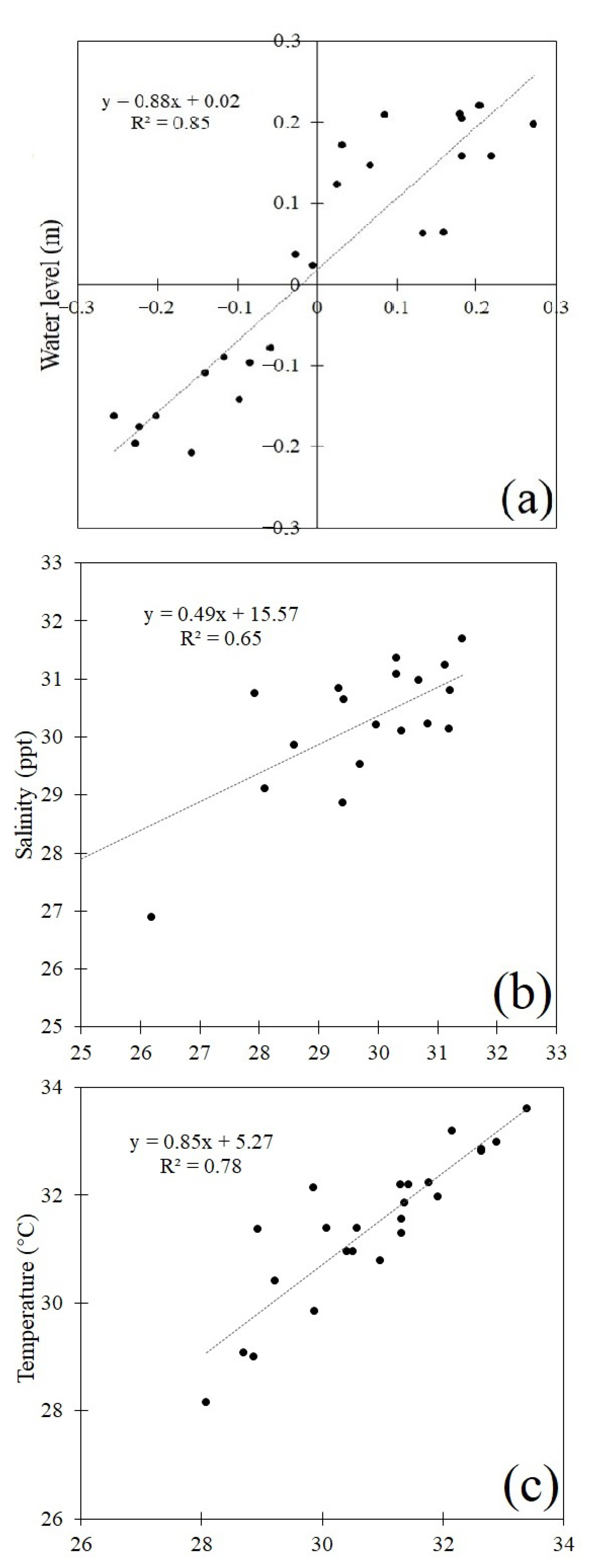Environmental Habitat Mapping of Green Mussel: A GIS-Based Approach for Sustainable Aquaculture in the Inner Gulf of Thailand
Abstract
:1. Introduction
2. Materials and Methods
2.1. Study Area
2.2. Environmental Data
2.2.1. Field Measurements
2.2.2. Hydrodynamic Data
2.2.3. Remote Sensing Data and Processing
2.3. SASSM Development
2.4. Correlation Analysis
3. Results
3.1. Seasonal Variations of Environmental Factors
3.2. Constructed Models
3.3. Final Seasonal SASSM Maps
3.4. Inter-Annual Variation of the Suitability Map
3.5. Zoning Analysis
4. Discussions
4.1. Effects of Changing Environment on Suitability
4.2. Suitable Area Comparison between 2018 and 2019
5. Conclusions
Author Contributions
Funding
Acknowledgments
Conflicts of Interest
References
- Rajagopal, S.; Venugopalan, V.P.; van der Velde, G.; Jenner, H.A. Greening of the coasts: A review of the perna viridis success story. Aquat. Ecol. 2006, 40, 273–297. [Google Scholar] [CrossRef]
- Wanrigo, V. Satisfaction of Farmers in Chonburi Province on Practice Adhering to Good Aquaculture Practice for Green Mussel Farm. Master’s Thesis, Sukhothai Thammathirat Open University, Nonthaburi, Thailand, 2012. (In Thai). [Google Scholar]
- National Introduced Marine Pest Information System (NIMPIS). Asian Green Mussel, Perna viridis (Linnaeus, 1785); Natural Heritage Trust: Melbourne, Australia, 2002. [Google Scholar]
- Chalermwat, K.; Szuster, B.W.; Flaherty, M. Shellfish aquaculture in Thailand. Aquac. Econ. Manag. 2003, 7, 249–261. [Google Scholar] [CrossRef]
- Noor, N.M.; Nursyam, H.; Widodo, M.S.; Risjani, Y. Biological aspects of green mussels Perna viridis cultivated on raft culture in pasaran coastal waters, indonesia. AACL Bioflux 2019, 12, 448–456. [Google Scholar]
- Food and Agriculture Organization. Topics Fact Sheets; (FAO) Fisheries and Aquaculture Department: Rome, Italy, 2020. [Google Scholar]
- Stadmark, J.; Conley, D.J. Mussel farming as a nutrient reduction measure in the baltic sea: Consideration of nutrient biogeochemical cycles. Mar. Pollut. Bull. 2011, 62, 1385–1388. [Google Scholar] [CrossRef]
- Srisunont, C.; Babel, S. Estimating the carrying capacity of green mussel cultivation by using net nutrient removal model. Mar. Pollut. Bull. 2016, 112, 235–243. [Google Scholar] [CrossRef]
- Tantanasarit, C.; Babel, S.; Englande, A.J.; Meksumpun, S. Influence of size and density on filtration rate modeling and nutrient uptake by green mussel (Perna viridis). Mar. Pollut. Bull. 2013, 68, 38–45. [Google Scholar] [CrossRef]
- Gao, Q.; Xu, W.; Xu, X.; Liu, S.G.; Cheung; Shin, P.K.S. Seasonal changes in C, N and P budgets of green-lipped mussels Perna viridis and removal of nutrients from fish farming in Hong Kong. Mar. Ecol. Prog. Ser. 2008, 353, 137–146. [Google Scholar] [CrossRef] [Green Version]
- Riisgård, H.U.L.; Bøttiger, L.; Pleissner, D. Effect of Salinity on Growth of Mussels, Mytilus edulis, with Special Reference to Great Belt (Denmark). Open J. Mar. Sci. 2012, 2, 167–176. [Google Scholar] [CrossRef] [Green Version]
- Fang, J.K.H.; Wu, R.S.S.; Chan, A.K.Y.; Yip, C.K.M.; Shin, P.K.S. Influences of ammonia-nitrogen and dissolved oxygen on lysosomal integrity in green-lipped mussel Perna viridis: Laboratory evaluation and field validation in Victoria Harbour, Hong Kong. Mar. Pollut. Bull. 2008, 56, 2052–2058. [Google Scholar] [CrossRef]
- Soon, T.K.; Ransangan, J. Feasibility of green mussel, Perna viridis farming in Marudu Bay, Malaysia. Aquac. Rep. 2016, 4, 130–135. [Google Scholar] [CrossRef] [Green Version]
- Marks, D. Climate change and thailand: Impact and response. Contemp. Southeast Asia J. Int. Strategic Aff. 2011, 33, 229–258. [Google Scholar] [CrossRef]
- Buranapratheprat, A.; Niemann Olaf, K.; Yanagi, T.; Matsumura, S.; Sojisuporn, P. Circulation in the Upper Gulf of Thailand Investigated Using a Three-Dimensional Hydrodynamic Model. Burapha Sci. J. 2009, 1, 99–113. [Google Scholar]
- Liu, Y.; Saitoh, S.-I.; Radiarta, I.N.; Igarashi, H.; Hirawake, A.T. Spatiotemporal variations in suitable areas for Japanese scallop aquaculture in the Dalian coastal area from 2003 to 2012. Aquaculture 2014, 422–423, 172–183. [Google Scholar] [CrossRef] [Green Version]
- Liu, Y.; Saitoh, S.-I.; Radiarta, I.N.; Isada, T.; Hirawake, T.; Mizuta., H.; Yasui, H. Improvement of an aquaculture site-selection model for Japanese kelp (Saccharina japonica) in southern Hokkaido, Japan: An application for the impacts of climate events. ICES J. Mar. Sci. 2013, 70, 1460–1470. [Google Scholar] [CrossRef] [Green Version]
- Liu, Y.; Saitoh, S.-I.; Igarashi, H.; Hirawake, T. The regional impacts of climate change on coastal environments and the aquaculture of Japanese scallops in northeast Asia: Case studies from Dalian, China, and Funka Bay, Japan. Int. J. Remote Sens. 2014, 35, 4422–4440. [Google Scholar] [CrossRef]
- Liu, Y.; Saitoh, S.-I.; Ihara, Y.; Nakada, S.; Kanamori, M.; Zhang, X.; Baba, K.; Ishikawa, Y.; Hirawake, T. Development of a three-dimensional growth prediction model for the Japanese scallop in Funka Bay, japan, using OGCM and MODIS. ICES J. Mar. Sci. 2015, 72, 2684–2699. [Google Scholar] [CrossRef] [Green Version]
- Saitoh, S.-I.; Mugo, R.; Radiarta, I.N.; Asaga, S.; Takahashi, F.; Hirawake, T.; Ishikawa, Y.; Awaji, T.; In, T.; Shima, A.S. Some operational uses of satellite remote sensing and marine GIS for sustainable fisheries and aquaculture. ICES J. Mar. Sci. 2011, 68, 687–695. [Google Scholar] [CrossRef] [Green Version]
- Radiarta, I.N.; Saitoh, S.-I.; Miyazono, A. GIS-based multi-criteria evaluation models for identifying suitable sites for Japanese scallop (Mizuhopecten yessoensis) aquaculture in Funka Bay, southwestern Hokkaido, Japan. Aquaculture 2008, 284, 127–135. [Google Scholar] [CrossRef]
- Teeramaethee, J. Culture of Green Mussel (Perna viridis Linnaeus) Hanging under Floating Cage Frame, Raft Foam and Long-Lines Methods. Master’s Thesis, Kasetsart University, Bangkok, Thailand, 1998. [Google Scholar]
- Department of Fisheries, M.o.A.a.C. Green Mussel Farming, Fishery Technology Transfer and Development. Technical Paper. 2007, 9. [Google Scholar]
- Phromkot, P.; Buranapratheprat, A.; Morimoto, A.; Gunbua, V.; Jintasaranee, P. The Application of a Box Model to Investigate the Behavior of Dissolved Inorganic Nutrients in the Inner Gulf of Thailand. Burapha Sci. J. 2019, 24, 1085–1097. [Google Scholar]
- Deltares. Simulation of Multi-Dimensional Hydrodynamic Flows and Transport Phenomena, including Sediments; Delft3D-FLOW-User Manual Release 3.14; Deltares: Delft, The Netherland, 2011. [Google Scholar]
- Hersbach, H.; Bell, B.; Berrisford, P. The ERA5 global reanalysis. Q. J. R. Meteorol. Soc. 2020, 146, 1999–2019. [Google Scholar] [CrossRef]
- Sudheer, J.; Ravichandran, M.; Praveen Kumar, B.; Raju Jampana, V.; Han, W. Ocean atmosphere thermal decoupling in the eastern equatorial Indian ocean. Clim. Dyn. 2016, 49, 575–594. [Google Scholar]
- Sallih, K. Mussel Farming in the State of Sarawak, Malaysia: A Feasibility Study; United Nations University: Reykjavik, Iceland, 2005; pp. 5–44. [Google Scholar]
- Malczewski, J. On the use of weighted linear combination method in GIS: Common and best practice approach. Trans. GIS 2000, 4, 5–22. [Google Scholar] [CrossRef]
- Department of Fisheries, Ministry of Agriculture and Cooperatives. Control Aquaculture Area Map, Types of Aquaculture Sea Shells. 2020. Available online: https://www.arcgis.com/apps/webappviewer/index.html?id=a7d3acc7f31c404bb33c1095790ae4f1 (accessed on 16 August 2020).
- Cooley, S.R.; Doney, S.C. Anticipating ocean acidification’s economic consequences for commercial fisheries. Environ. Res. Lett. 2009, 4, 1–8. [Google Scholar] [CrossRef]
- Lafferty, K.D. The ecology of climate change and infectious diseases. Ecology 2009, 90, 888–900. [Google Scholar] [CrossRef]
- Lafferty, K.D.; Porter, J.W.; Ford, S.E. Are diseases increasing in the ocean? Annu. Rev. Ecol. Evol. Syst. 2004, 35, 31–54. [Google Scholar] [CrossRef] [Green Version]
- Cook, T.; Folli, M.; Klinck, J.; Ford, S.; Miller, J. The relationship between increasing sea-surface temperature and the northward spread of Perkinsus marinus (Dermo) disease epizootics in oysters. Estuar. Coast. Shelf Sci. 1998, 46, 587–597. [Google Scholar] [CrossRef]
- Rajagopal, S.; Venugopalan, V.P.; Nair, K.V.K.; van der Velde, G.; Jenner, H.A.; Hartog, C. Reproduction, growth rate and culture potential of the green mussel, Perna viridis (L.) on Edaiyur backwaters, east coast of india. Aquaculture 1998, 162, 187–202. [Google Scholar] [CrossRef]
- Blanchette, C.A.; Helmuth, B.; Gaines, S.D. Spatial pattern of growth in the mussel, mytilus californianus, across a major oceanographic and biogeographic boundary at Point Conception, California, USA. J. Exp. Mar. Biol. Ecol. 2007, 340, 126–148. [Google Scholar] [CrossRef]










| Rating Point | Salinity (ppt) | Temperature (°C) | Chl-a (ug/L) | Water Current (m/s) | Depth (m) |
|---|---|---|---|---|---|
| 7 | 28–30 | 25–27 | 2.0–3.0 | 0.1–0.12 | >8.0 |
| 6 | 26–28 30–32 | 23–25 27–29 | 1.8–2.0 3.0–3.5 | 0.12–0.13 | 7.0–8.0 |
| 5 | 24–26 32–34 | 21–23 29–31 | 1.6–1.8 3.5–4.0 | 0.13–0.14 | 6.0–7.0 |
| 4 | 22–24 34–36 | 19–21 31–33 | 1.4–1.6 4.0–4.5 | 0.14–0.15 | 5.0–6.0 |
| 3 | 20–22 36–38 | 17–19 33–35 | 1.2–1.4 4.5–5.0 | 0.15–0.16 | 4.0–5.0 |
| 2 | 18–20 38–40 | 15–17 35–37 | 1.0–1.2 5.0–5.5 | 0.16–0.17 | 2.0–4.0 |
| 1 | 16–18 40–42 | 13–15 37–39 | 0.0–1.0 5.5–100 | 0.17–100 | 0–2.0 |
| Weighted value | 0.25 | 0.25 | 0.2 | 0.15 | 0.15 |
| Year | Suitability Scores (%) | ||||||
|---|---|---|---|---|---|---|---|
| 1 | 2 | 3 | 4 | 5 | 6 | 7 | |
| Western | |||||||
| Summer 2018 | 0 | 16 | 52 | 32 | 0 | 0 | 0 |
| Summer 2019 | 0 | 22 | 53 | 25 | 0 | 0 | 0 |
| Rainy season 2018 | 0 | 53 | 31 | 16 | 0 | 0 | 0 |
| Rainy season 2019 | 0 | 11 | 50 | 39 | 0 | 0 | 0 |
| Cold season 2018 | 0 | 39 | 28 | 33 | 0 | 0 | 0 |
| Cold season 2019 | 0 | 31 | 35 | 15 | 19 | 0 | 0 |
| Middle | |||||||
| Summer 2018 | 0 | 27 | 18 | 56 | 0 | 0 | 0 |
| Summer 2019 | 0 | 22 | 53 | 25 | 0 | 0 | 0 |
| Rainy season 2018 | 0 | 21 | 10 | 36 | 21 | 12 | 0 |
| Rainy season 2019 | 0 | 12 | 12 | 55 | 18 | 3 | 0 |
| Cold season 2018 | 0 | 5 | 47 | 16 | 21 | 11 | 0 |
| Cold season 2019 | 0 | 35 | 46 | 15 | 4 | 0 | 0 |
| Eastern | |||||||
| Summer 2018 | 0 | 0 | 7 | 30 | 35 | 28 | 0 |
| Summer 2019 | 0 | 0 | 5 | 31 | 38 | 26 | 0 |
| Rainy season 2018 | 0 | 0 | 5 | 35 | 33 | 28 | 0 |
| Rainy season 2019 | 0 | 0 | 5 | 29 | 31 | 36 | 0 |
| Cold season 2018 | 0 | 0 | 4 | 38 | 29 | 29 | 0 |
| Cold season 2019 | 0 | 6 | 36 | 28 | 17 | 14 | 0 |
| Air Temp | Rainfall | Wind | MWC | SST | Salinity | Chl-a | |
|---|---|---|---|---|---|---|---|
| Western | |||||||
| Air temperature | 1 | ||||||
| Rainfall | 0.638 * | 1 | |||||
| Wind | 0.597 * | 0.458 | 1 | ||||
| MC | 0.809 ** | 0.579 * | 0.666 * | 1 | |||
| SST | 0.959 ** | 0.625 * | 0.548 | 0.666 * | 1 | ||
| Salinity | −0.43 | −0.616 * | −0.213 | −0.623 * | −0.359 | 1 | |
| Chl-a | 0.157 | 0.173 | 0.079 | 0.45 | 0.101 | −0.702 * | 1 |
| Middle | |||||||
| Air temperature | 1 | ||||||
| Rainfall | 0.024 | 1 | |||||
| Wind | −0.165 | −0.044 | 1 | ||||
| MC | 0.408 | 0.726 ** | 0.055 | 1 | |||
| SST | 0.898 ** | 0.291 | −0.28 | 0.559 | 1 | ||
| Salinity | −0.492 | −0.726 ** | 0.304 | −0.752 ** | −0.744 ** | 1 | |
| Chl-a | 0.056 | 0.223 | 0.311 | 0.243 | 0.272 | −0.082 | 1 |
| Eastern | |||||||
| Air temperature | 1 | ||||||
| Rainfall | 0.391 | 1 | |||||
| Wind | 0.394 | 0.471 | 1 | ||||
| MC | 0.356 | 0.454 | 0.007 | 1 | |||
| SST | 0.901 ** | 0.423 | 0.413 | 0.456 | 1 | ||
| Salinity | −0.39 | −0.819 ** | −0.562 | −0.475 | −0.311 | 1 | |
| Chl-a | 0.439 | 0.389 | 0.653 * | 0.343 | 0.5 | −0.667 * | 1 |
Publisher’s Note: MDPI stays neutral with regard to jurisdictional claims in published maps and institutional affiliations. |
© 2020 by the authors. Licensee MDPI, Basel, Switzerland. This article is an open access article distributed under the terms and conditions of the Creative Commons Attribution (CC BY) license (http://creativecommons.org/licenses/by/4.0/).
Share and Cite
Kumgumpol, H.; Liu, Y.; Pokavanich, T.; Alabia, I.D.; Yin, Z.; Saitoh, S.-I.; Tian, Y. Environmental Habitat Mapping of Green Mussel: A GIS-Based Approach for Sustainable Aquaculture in the Inner Gulf of Thailand. Sustainability 2020, 12, 10643. https://0-doi-org.brum.beds.ac.uk/10.3390/su122410643
Kumgumpol H, Liu Y, Pokavanich T, Alabia ID, Yin Z, Saitoh S-I, Tian Y. Environmental Habitat Mapping of Green Mussel: A GIS-Based Approach for Sustainable Aquaculture in the Inner Gulf of Thailand. Sustainability. 2020; 12(24):10643. https://0-doi-org.brum.beds.ac.uk/10.3390/su122410643
Chicago/Turabian StyleKumgumpol, Hathaichanok, Yang Liu, Tanuspong Pokavanich, Irene D. Alabia, Zixu Yin, Sei-Ichi Saitoh, and Yongjun Tian. 2020. "Environmental Habitat Mapping of Green Mussel: A GIS-Based Approach for Sustainable Aquaculture in the Inner Gulf of Thailand" Sustainability 12, no. 24: 10643. https://0-doi-org.brum.beds.ac.uk/10.3390/su122410643







